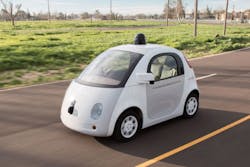The unknown can be scary, my friends. I get that. And that’s why I’m never surprised by the recurring questions I receive about autonomous vehicles.
It’s all we hear about these days in the press: Tesla’s AutoPilot. Google’s self-driving vehicle. No more drivers needed. No more accidents. Ever.
It’s that last part that means doom and gloom for us, right? I mean, no more accidents means there is no longer a need for the folks who repair the vehicles that were in those accidents. Our businesses will close. Our industry will crumble. Our …OK, let’s take a deep breathe.
Now repeat after me: We will be just fine.
Not feeling better yet? Well, let’s talk this out. I get shop operators asking me about autonomous vehicles everywhere I go. Every market in every corner of the country seems concerned about what self-driving cars will mean for our industry. My answer? I think we’re already looking at this all wrong.
Let’s start with some background: For many years now, automakers have been tightly focused on reaching the miles-per-gallon benchmarks set in the revisions to the CAFE standards. Achieving 53 mpg has been the focus for years, and that’s where this rapid change in vehicle development originated. Smarter, leaner, more technologically efficient vehicles should lead to better fuel economy across the U.S. fleet. And in this technology race came advanced safety features.
We read a lot about self-driving cars, but that’s a very small piece of this puzzle. The media buzz might distract from it, but automakers aren’t trying to eliminate drivers; they’re trying to enhance the driver experience, which includes making each driver safer. A world with no accidents simply isn’t realistic at this point (I’ll get to more on that later); what is realistic is automakers being able to take a 60 mph crash and turn it into a 40 mph crash, or a 40 mph crash into a 20 mph crash.
I had a conversation with Toyota recently, and they were kind enough to point out the three biggest causes of accident-related injuries and fatalities:
- Vehicle-on-vehicle collisions
- Traffic lane departures
- Poor night visibility
Yes, Toyota has its own widely publicized autonomous driving project, but in my conversations with them, they say their work is based on finding solutions to those three issues outlined above. Adaptive cruise control, advanced braking systems, lane deviation prevention sensors, adaptive headlights—these are the real solutions. Yes, those features lead us down the path to autonomy, but it’s a long path, my friends.
For us—for the collision repair industry—all of this doesn’t lead to doom and gloom; it might just be the opposite. But, we will have to shift our own focus. An example: Parking sensors and backup cameras are now becoming standard and required in new vehicles; this means we’ll have to do a much better job researching OE repair information to know how that affects your work. You might have a simple R&I for a bumper cover, but that bumper cover might house blind-spot sensors that require recalibration. And certain automakers require you to test drive a vehicle for a certain amount of time at a certain speed in order to fully recalibrate a sensor.
That’s just one, small, specific example, but it demonstrates how it changes the way we approach and estimate damage. Technology has changed the way we work—the way we must work to provide a safe and proper repair.
Autonomous vehicles? Yeah, it’s all the buzz, and that’s not going to stop, but neither is your business and neither is this industry. Here’s your first reason: There are roughly 253 million vehicles on the road in the U.S. Even if every manufacturer came out with a fully self-driving vehicle in 2017, it would take a very long time for that total fleet to turnover, especially when you consider that length of ownership is on the rise (the average vehicle in the U.S. is 11.4 years old).
Also, as of now, self-driving cars are being designed to react in “perfect” or “ideal” driving scenarios. They not only perform “perfect” stops, but they rely on others to do the same. Imagine being behind one at an intersection, anticipating the “California rolling stop,” and then plowing right into them. (Not-coincidentally, Google has come out to say it is trying to make its vehicles drive more aggressively to better mimic patterns of real drivers.) Then there’s the issue of weather—snow, ice, rain, etc.—and deer jumping out in the road. And what about a traffic light being out? Or a police officer stopping traffic for a funeral procession, one that flows through a red light while a self-driving car approaches from the other direction, heading toward a still-operating green light?
Yes, autonomous technology is gearing up, but it has a long, long way to go. OEs aren’t ready to create this world yet, and vehicle owners aren’t ready to participate in it. What will happen, though, is safer, more sophisticated vehicles. Those 60 mph crashes might turn into 40 mph crashes because of it, and that could lead to fewer totals; that’s good news for us.
My message for you, my friends, is not to get caught up in the doom and gloom. Don’t be afraid of the future—but don’t ignore it, either. We will succeed if we go forward with a thoughtful approach. Once we have that, the future isn’t as much of an unknown. And all of it becomes a lot less scary.
About the Author

Mike Anderson
Mike Anderson, the former owner of Wagonwork Collision Centers in Alexandria, Va., operates CollisionAdvice.com, a training and consulting firm that assists shop operators nationwide. He is also a facilitator for Axalta Coating Systems’ 20 Groups in the U.S. and Canada, and is an Accredited Automotive Manager. Reach Anderson at [email protected].
